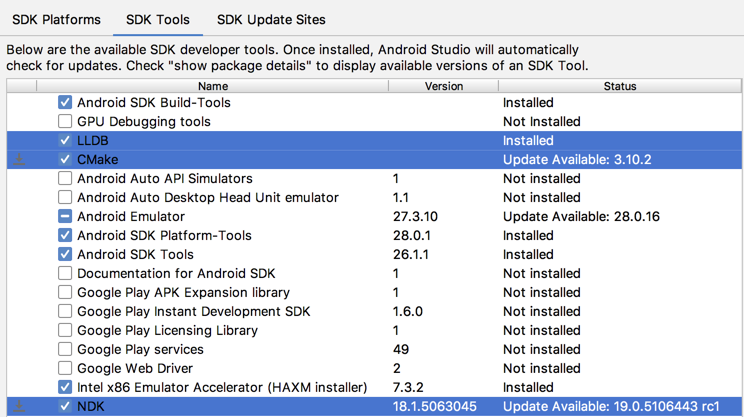

- #CMAKE ANDROID NDK EXAMPLE HOW TO#
- #CMAKE ANDROID NDK EXAMPLE APK#
- #CMAKE ANDROID NDK EXAMPLE SOFTWARE#
- #CMAKE ANDROID NDK EXAMPLE DOWNLOAD#
Luckily, you can simply avoid adventuring through all the trouble of setting up the preferred tools by using the defaults provided to you in Android Studio. To open this dialog, you can right-click the project and select “Open Module Settings.” It is under the “SDK Location” tab on the left-hand side panel. When all these tools are installed, the most important thing you want to check is whether you have the NDK default directory pointing to the downloaded package, as in Figure 1.
#CMAKE ANDROID NDK EXAMPLE DOWNLOAD#
Then, you’ll need to download your preferred native compiler for example, the freely available CMake. The NDK download is also available, so you can download the package and do it manually after choosing the correct platform.

Downloading and Installing NDK-related Toolsīecause Android is only fully supported in the Android Studio IDE, I would recommend you go ahead and get its latest version (3.0.1 as of now). Finally, we walk through a more complicated example to illustrate the NDK basics. Next, we try a hello-world build just to make sure everything is set up correctly.
#CMAKE ANDROID NDK EXAMPLE HOW TO#
First, we provide the info where to download the NDK libraries, how to install them, and what components to verify before you start. In this tutorial, we try to cover the fundamental steps required in NDK development and point out the key resources to further explore the advanced aspects of the toolsets. It also comes in handy for those who simply want to incorporate some existing libraries done in other computer languages other than Android’s own without re-inventing the wheel. Usually, developers who consider fine-tuning the device performance or implementing apps with computationally-intensive operations will need to look into this option. However, it is certainly not for everyone, considering the knowledge and complexity involved.

#CMAKE ANDROID NDK EXAMPLE SOFTWARE#
Add a line to the end of the app/build.In addition to the Android Software Development Kit (SDK), NDK is Android’s Native Development Kit that provides the option for the support of integrating native coding development from other computer languages such as C, C++, Kotlin, and so on. It’s time to add automatic execution of this task during the project build. You will see the freshly compiled *.so files in the app/src/main/jniLibs directory if the compilation was successful. We can run this task now with gradle runNdkBuild command. NDK_APPLICATION_MK - specifies the path to the Application.mk file, where we put the compilation settings You will also have to override the property .srcDirs if you need to specify a different directory here.ĪPP_BUILD_SCRIPT - specifies the path to our build script Android.mk
#CMAKE ANDROID NDK EXAMPLE APK#
Here we specify the path src/main/jniLibs because the libraries from this directory are automatically included in the APK after compiling the project. NDK_LIBS_OUT - the directory in which the libraries will be located after compilation. We also pass an array of arguments for the command in the args property: To do this, we get the path to the installed NDK in the first line and add the name "/ndk-build" to it. We must assign the path to the command to the executable property. Tasks of Exec type are used to run external commands.

In the app/adle file we configure the library build via CMake in the usual way: You can view the files in the app/src/main/jni/ directory. I created a simple project on GitHub with two C libraries: one with a build script CMakeLists.txt and the other built via Android.mk. But I don’t want to run it manually every time, so in this article, we will use Gradle’s ability to invoke external commands and configure ndk-build to run automatically during application build. The most obvious solution would be to use CMake by default and run ndk-build separately. I will show one of the possible ways to solve this problem. But if you specify two paths to the build scripts CMakeLists.txt and Android.mk in the adle file, then Gradle will show an error “More than one externalNativeBuild path specified” and will not compile anything. You may need to use both build systems at the same time to compile some existing libraries. Android NDK currently provides us with at least two ways to build native libraries: CMake and ndk-build.


 0 kommentar(er)
0 kommentar(er)
